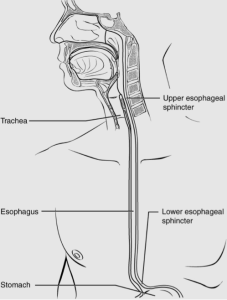Esophageal Anatomy
The esophagus is a collapsed muscular tube that goes from the pharynx to the stomach (Box 1.29). It is approximately 20 to 25 cm long in the average adult. The length of the tube contains two layers of muscle— an inner circular muscle and an outer longitudinal muscle. The upper 1/3 of the esophagus is striated muscle, the bottom 1/3 of the esophagus is smooth muscle, and the middle section is a transition between striated and smooth muscle. The esophageal muscles are largely innervated by CN X.
Box 1.29: Esophagus

By OpenStax College [CC BY 3.0 (https://
The esophagus has a sphincter region at each end. The tonically contracted region at the top of the esophagus is referred to as the upper esophageal sphincter (UES) or the pharyngo-esophageal segment (PE segment); at the bottom is the lower esophageal sphincter (LES). In the field of speech pathology, a dysphagia clinician should inspect the UES and therefore needs familiarity with the anatomy (described previously). Remember that the UES is tonically active and relaxes to allow the passage of a bolus into the esophagus. The UES also helps to keep air out of the esophagus, and keeps food, once entered into the esophagus, from coming back into the pharynx. This prevention of esophageal back-flow into the pharynx provides protection of the airway and lungs. In addition to allowing passage of bolus into the stomach, the LES keeps secretions and stomach acid in the stomach and prevents them from penetrating back up, thus avoiding contact with the delicate esophageal tissue.
Clinical Note
Extra esophageal reflux (a.k.a. laryngopharyngeal reflux) can result in aspiration after the swallow and even after the completion of mealtime.

